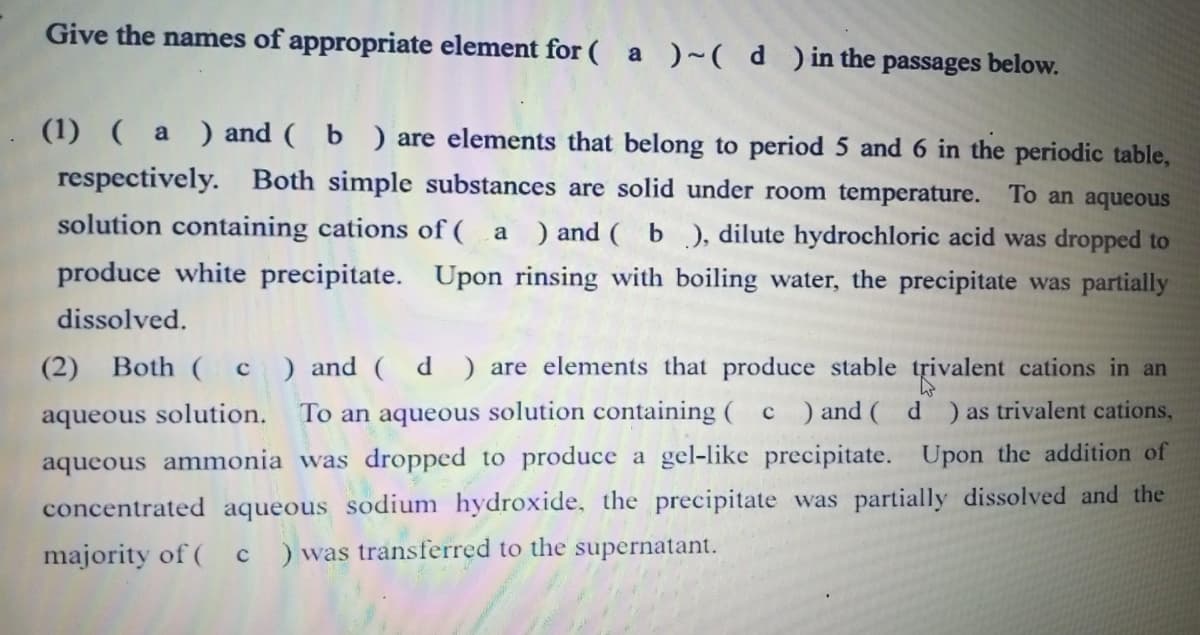(1) (a) and (b) are elements that belong to period 5 and 6 in the periodic table, respectively. Both simple substances are solid under room temperature. To an aqueous solution containing cations of (a) and (b), dilute hydrochloric acid was dropped to produce white precipitate. Upon rinsing with boiling water, the precipitate was partially dissolved. (2) Both (c) and (d) are elements that produce stable trivalent cations in an aqueous solution. To an aqueous solution containing (c) and (d) as trivalent cations, aqueous ammonia was dropped to produce a gel-like precipitate. Upon the addition of concentrated aqueous sodium hydroxide, the precipitate was partially dissolved and the majority of ( c) was transferred to the supernatant.
(1) (a) and (b) are elements that belong to period 5 and 6 in the periodic table, respectively. Both simple substances are solid under room temperature. To an aqueous solution containing cations of (a) and (b), dilute hydrochloric acid was dropped to produce white precipitate. Upon rinsing with boiling water, the precipitate was partially dissolved. (2) Both (c) and (d) are elements that produce stable trivalent cations in an aqueous solution. To an aqueous solution containing (c) and (d) as trivalent cations, aqueous ammonia was dropped to produce a gel-like precipitate. Upon the addition of concentrated aqueous sodium hydroxide, the precipitate was partially dissolved and the majority of ( c) was transferred to the supernatant.
Principles of Modern Chemistry
8th Edition
ISBN:9781305079113
Author:David W. Oxtoby, H. Pat Gillis, Laurie J. Butler
Publisher:David W. Oxtoby, H. Pat Gillis, Laurie J. Butler
Chapter17: Electrochemistry
Section: Chapter Questions
Problem 80AP
Related questions
Question

Transcribed Image Text:Give the names of appropriate element for (a)~(d) in the passages below.
(1) (a) and (b) are elements that belong to period 5 and 6 in the periodic table,
respectively. Both simple substances are solid under room temperature. To an aqueous
solution containing cations of (a) and (b), dilute hydrochloric acid was dropped to
produce white precipitate. Upon rinsing with boiling water, the precipitate was partially
dissolved.
(2) Both (c) and (d) are elements that produce stable trivalent cations in an
aqueous solution. To an aqueous solution containing (c) and (d) as trivalent cations,
aqueous ammonia was dropped to produce a gel-like precipitate. Upon the addition of
concentrated aqueous sodium hydroxide, the precipitate was partially dissolved and the
majority of (c ) was transferred to the supernatant.
Expert Solution
This question has been solved!
Explore an expertly crafted, step-by-step solution for a thorough understanding of key concepts.
Step by step
Solved in 3 steps

Knowledge Booster
Learn more about
Need a deep-dive on the concept behind this application? Look no further. Learn more about this topic, chemistry and related others by exploring similar questions and additional content below.Recommended textbooks for you

Principles of Modern Chemistry
Chemistry
ISBN:
9781305079113
Author:
David W. Oxtoby, H. Pat Gillis, Laurie J. Butler
Publisher:
Cengage Learning


Principles of Modern Chemistry
Chemistry
ISBN:
9781305079113
Author:
David W. Oxtoby, H. Pat Gillis, Laurie J. Butler
Publisher:
Cengage Learning
